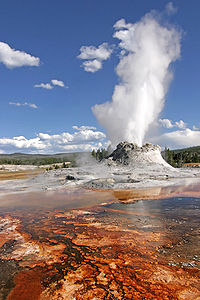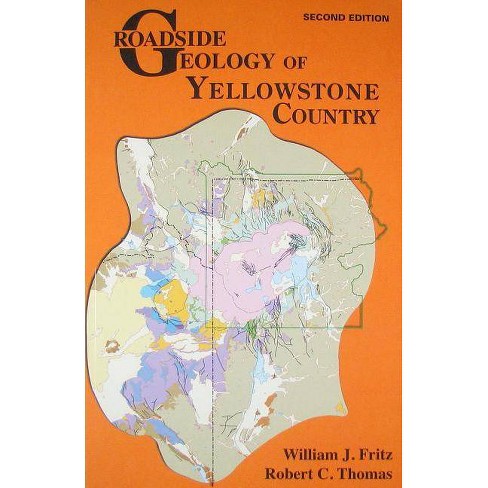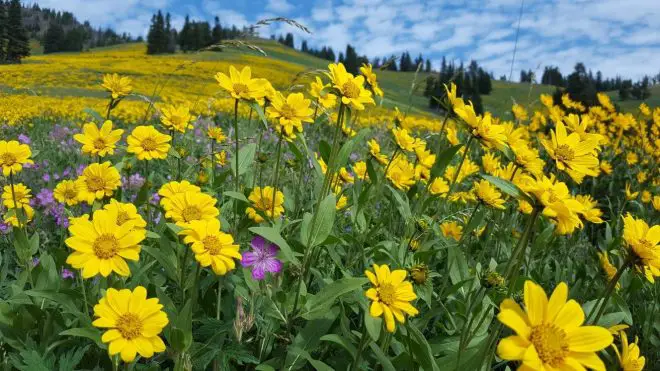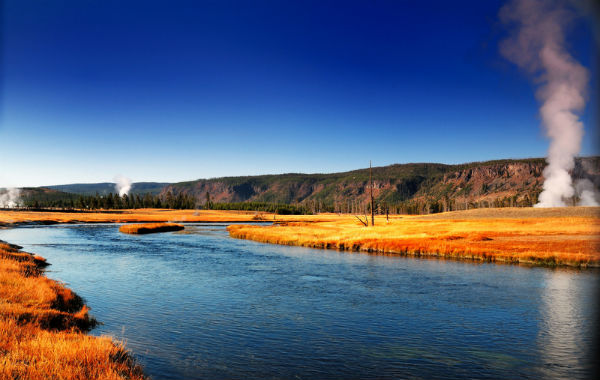Yellowstone is located at the headwaters of the Yellowstone RiverW, from which it takes its historical name. Near the end of the 18th century, French trappers named the river “Roche Jaune,” which is probably a translation of the Minnetaree name “Mi tsi a-da-zi” (Rock Yellow River). Later, American trappers rendered the French name in English as “Yellow Stone.” Although it is commonly believed that the river was named for the yellow rocks seen in the Grand Canyon of the YellowstoneW, the Native American name source is not clear. The human history of the park begins at least 11,000 years ago when aboriginal Americans first began to hunt and fish in the region. During the construction of the post office in Gardiner, Montana, in the 1950s, an obsidian projectile point of Clovis origin was found that dated from approximately 11,000 years ago. These Paleo-Indians, of the Clovis culture, used the significant amounts of obsidian found in the park to make such cutting tools and weapons. Arrowheads made of Yellowstone obsidian have been found as far away as the Mississippi Valley, indicating that a regular obsidian trade existed between local tribes and tribes farther east. By the time white explorers first entered the region during the Lewis and Clark Expedition in 1805, they encountered the Nez Perce, Crow and Shoshone tribes. While passing through present day Montana, the expedition members were informed of the Yellowstone region to the south, but they did not investigate it.
In 1806, John Colter, a member of the Lewis and Clark ExpeditionW, left to join a group of fur trappers. After splitting up with the other trappers in 1807, Colter passed through a portion of what later became the park, during the winter of 1807–1808. He observed at least one geothermal area in the northeastern section of the park, near Tower Fall. After surviving wounds he suffered in a battle with members of the Crow and Blackfoot tribes in 1809, he gave a description of a place of “fire and brimstone” that was dismissed by most people as delirium. The supposedly imaginary place was nicknamed “Colter’s HellW.” Over the next forty years, numerous reports from mountain men and trappers told of boiling mud, steaming rivers and petrified trees, yet most of these reports were believed at the time to be myth.
After an 1856 exploration, mountain man Jim BridgerW reported observing boiling springs, spouting water, and a mountain of glass and yellow rock. These reports were largely ignored because Bridger was known for being a “spinner of yarns”. In 1859, Captain William F. Raynolds, U.S. Army surveyor embarked on a two year survey of the northern Rockies. After wintering in Wyoming, in May 1860, Raynolds and his party which included naturalist Ferdinand Vandeveer HaydenW and guide Jim Bridger attempted to cross the Continental Divide over Two Ocean Plateau from the Wind River drainage in northwest Wyoming. Heavy spring snows prevented their passage but had they been able to traverse the divide, the party would have been the first organized survey to enter the Yellowstone region. The American Civil War hampered further organized explorations until the late 1860s.
Henry D. Washburn
The first detailed expedition to the Yellowstone area was the Cook-Folsom-Peterson ExpeditionWof 1869, which consisted of three privately funded explorers. The Folsom party followed the Yellowstone River to Yellowstone Lake. The members of the Folsom party kept a journal and based on the information it reported, a party of Montana residents organized the Washburn-Langford-Doane ExpeditionW in 1870. It was headed by the surveyor-general of Montana Henry D. WashburnW, and included Nathaniel P. LangfordW (who later became known as “National Park” Langford) and a U.S. Army detachment commanded by Lt. Gustavus Doane. The expedition spent about a month exploring the region, collecting specimens, and naming sites of interest. A Montana writer and lawyer named Cornelius Hedges, who had been a member of the Washburn expedition, proposed that the region should be set aside and protected as a National Park; he wrote a number of detailed articles about his observations for the Helena Herald newspaper between 1870 and 1871. Hedges essentially restated comments made in October 1865 by acting Montana Territorial Governor Thomas Francis Meagher, who had previously commented that the region should be protected. Others made similar suggestions. In an 1871 letter from Jay Cooke to Ferdinand Hayden, Cooke wrote that his friend, Congressman William D. Kelley had also suggested “Congress pass a bill reserving the Great Geyser Basin as a public park forever”.
Park Creation
In 1871, eleven years after his failed first effort, F.V. Hayden was finally able to make another attempt to explore the region. With government sponsorship, Hayden returned to Yellowstone region with a second, larger expedition, the Hayden Geological Survey of 1871W. He compiled a comprehensive report on Yellowstone, which included large-format photographs by William Henry JacksonW, as well as paintings by Thomas MoranW. His report helped to convince the U.S. Congress to withdraw this region from public auction; on March 1, 1872, President Ulysses S. Grant signed The Act of Dedication law that created Yellowstone National Park.
THE ACT OF DEDICATION
AN ACT to set apart a certain tract of land lying near the headwaters of the Yellowstone River as a public park. Be it enacted by the Senate and House of Representatives of the United States of America in Congress assembled, That the tract of land in the Territories of Montana and Wyoming …. is hereby reserved and withdrawn from settlement, occupancy, or sale under the laws of the United States, and dedicated and set apart as a public park or pleasuring ground for the benefit and enjoyment of the people; and all persons who shall locate, or settle upon, or occupy the same or any part thereof, except as hereinafter provided, shall be considered trespassers and removed there from…
Approved March 1, 1872.
Signed by:
- JAMES G. BLAINE, Speaker of the House.
- SCHUYLER COLFAX, Vice-President of the United States and President of the Senate.
- ULYSSES S. GRANT, President of the United States.
Nathaniel P. Langford
Nathaniel Langford was appointed as the park’s first superintendent in 1872. He served for five years but was denied a salary, funding, and staff. Langford lacked the means to improve the land or properly protect the park, and without formal policy or regulations, he had few legal methods to enforce such protection. This left Yellowstone vulnerable to poachers, vandals, and others seeking to raid its resources. He addressed the practical problems park administrators faced in the 1872 Report to the Secretary of the Interior and correctly predicted that Yellowstone will become a major international attraction deserving the continuing stewardship of the government. In 1875, Colonel William Ludlow, who had previously explored areas of Montana under the command of George Armstrong Custer, was assigned to organize and lead an expedition to Montana and the newly established Yellowstone Park. Observations about the lawlessness and exploitation of park resources were included in Ludlow’s Report of a Reconnaissance to the Yellowstone Nation Park. The report included letters and attachments by other expedition members, including naturalist and mineralogist George Bird GrinnellW. Grinnell documented the poaching of buffalo, deer, elk and antelope for hides. “It is estimated that during the winter of 1874–1875, not less than 3,000 buffalo and mule deer suffer even more severely than the elk, and the antelope nearly as much.”
Philetus Norris
As a result, Langford was forced to step down in 1877. Having traveled through Yellowstone and witnessed land management problems first hand, Philetus NorrisW volunteered for the position following Langford’s exit. Congress finally saw fit to implement a salary for the position, as well as to provide a minimal funding to operate the park. Norris used these funds to expand access to the park, building numerous crude roads and facilities.
In 1880, Harry YountW was appointed as “gamekeeper” to control poaching and vandalism in the park. Yount had previously spent a number of years exploring the mountain country of present-day Wyoming, including the Grand Tetons, after joining Dr. Hayden’s Geological Survey in 1873. Today, he is considered the first national park ranger, and Younts Peak, located at the head of the Yellowstone River, was named in his honor. However, these measures still proved to be insufficient in protecting the park, as neither Norris, nor the three superintendents who followed, were given sufficient manpower or resources.
The Northern Pacific Railroad built a train station in Livingston, Montana, connecting to the northern entrance in the early 1880s, which helped to increase visitation from 300 in 1872 to 5,000 in 1883. Visitors in these early years were faced with poor roads and limited services, and most access into the park was on horse or via stagecoach. By 1908 visitation increased enough to also attract a Union Pacific Railroad connection to West Yellowstone, though rail visitation fell off considerably by World War II and ceased around the 1960s.
Chief Joseph
During the 1870s and 1880s Native American tribes were effectively excluded from the national park. A number of tribes had made seasonal use of the Yellowstone area, but the only year-round residents were small bands of Western Shoshone known as “Sheepeaters”. They left the area under the assurances of a treaty negotiated in 1868, under which the Sheepeaters ceded their lands but retained the right to hunt in Yellowstone. The United States never ratified the treaty and refused to recognize the claims of the Sheepeaters or any other tribe that had made use of Yellowstone. The Nez Perce band associated with Chief JosephW, numbering about 750 people, passed through Yellowstone National Park in thirteen days during late August, 1877. They were being pursued by the U.S. Army and entered the national park about two weeks after the Battle of the Big Hole. Some of the Nez Perce were friendly to the tourists and other people they encountered in the park, some were not. Nine park visitors were briefly taken captive. Despite Joseph and other chiefs ordering that no one should be harmed, at least two people were killed and several wounded. One of the areas where encounters occurred was in Lower Geyser Basin and east along a branch of the Firehole River to Marys Mountain and beyond. That stream is still known as Nez Perce Creek. A group of Bannocks entered the park in 1878, alarming park Superintendent Philetus Norris. In the aftermath of the Sheepeater Indian War of 1889, Norris built a fort for the purpose of preventing Native Americans from entering the national park.
Ongoing poaching and destruction of natural resources continued unabated until the U.S. Army arrived at Mammoth Hot Springs in 1886 and built Camp Sheridan. Over the next 22 years the army constructed permanent structures, and Camp Sheridan was renamed Fort Yellowstone. With the funding and manpower necessary to keep a diligent watch, the army developed their own policies and regulations that permitted public access while protecting park wildlife and natural resources. When the National Park Service was created in 1916, many of the management principles developed by the army were adopted by the new agency. The army turned control over to the National Park Service on October 31, 1918.
Later History
By 1915, 1,000 automobiles per year were entering the park, resulting in conflicts with horses and horse driven transportation. In subsequent years horse travel on roads was eventually prohibited. Between 1933 and 1941, the Civilian Conservation Corps built the majority of the early visitor centers, campgrounds and the current system of park roads. During World War II, staffing and visitation both decreased, and many facilities fell into disrepair. By the 1950s, visitation increased tremendously in Yellowstone and other national parks. To accommodate the increased visitation, park officials implemented Mission 66W, an effort to modernize and expand park service facilities. Planned to be completed by 1966, in honor of the 50th anniversary of the founding of the National Park Service, Mission 66 construction diverged from the traditional log cabin style with design features of a modern style. During the late 1980s, most construction styles in Yellowstone reverted back to the more traditional designs. After the enormous forest fires of 1988 damaged much of Grant Village, structures there were rebuilt in the traditional style. The visitor center at Canyon Village, which opened in 2006, incorporates a more traditional design as well.
The 1959 Yellowstone earthquakeW just west of Yellowstone at Hebgen Lake damaged roads and some structures in the park. In the northwest section of the park, new geysers were found, and many existing hot springs became turbid. It was the most powerful earthquake to hit the region in recorded history.
In 1963, after several years of public controversy regarding the forced reduction of the elk population in Yellowstone, United States Secretary of the Interior Stewart Udall appointed an advisory board to collect scientific data to inform future wildlife management of the national parks. In a paper known as the Leopold ReportW, the committee observed that culling programs at other national parks had been ineffective, and recommended management of Yellowstone’s elk population.
The wildfires during the summer of 1988 were the largest in the history of the park. Approximately 793,880 acres (1,240 sq mi) or 36% of the parkland was impacted by the fires, leading to a systematic reevaluation of fire management policies. The fire season of 1988 was considered normal until a combination of drought and heat by mid-July contributed to an extreme fire danger. On “Black Saturday,” August 20, 1988, strong winds expanded the fires rapidly, and more than 150,000 acres (230 sq mi) burned.
The expansive cultural history of the park has been documented by the 1,000 archeological sites that have been discovered. The park has 1,106 historic structures and features, and of these Obsidian Cliff and five buildings have been designated National Historic Landmarks. Yellowstone was designated an International Biosphere Reserve on October 26, 1976, and a United Nations World Heritage Site on September 8, 1978.
Heritage & Research Center
The Heritage and Research Center is located at Gardiner, Montana, near the north entrance to the park. The center is home to the Yellowstone National Park’s museum collection, archives, research library, historian, archeology lab, and herbarium. The Yellowstone National Park Archives maintain collections of historical records of Yellowstone and the National Park Service. The collection includes the administrative records of Yellowstone, the world’s first national park, as well as resource management records, records from major projects as well as donated manuscripts and personal papers. The archives are affiliated with the National Archives and Records Administration.

 Thermal Features
Thermal Features Geology
Geology Plant Life
Plant Life Rivers, Streams, & Lakes
Rivers, Streams, & Lakes Waterfalls
Waterfalls